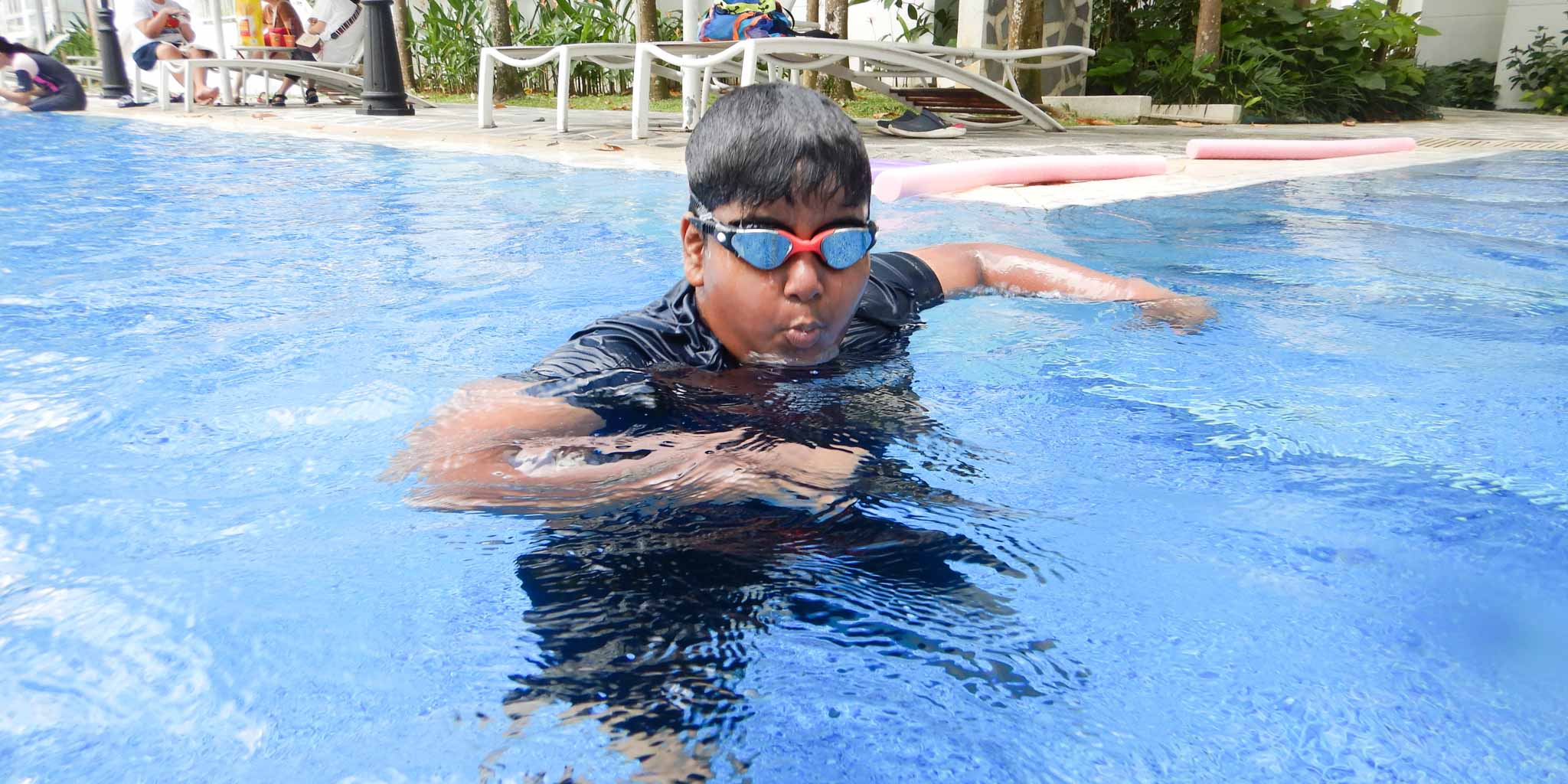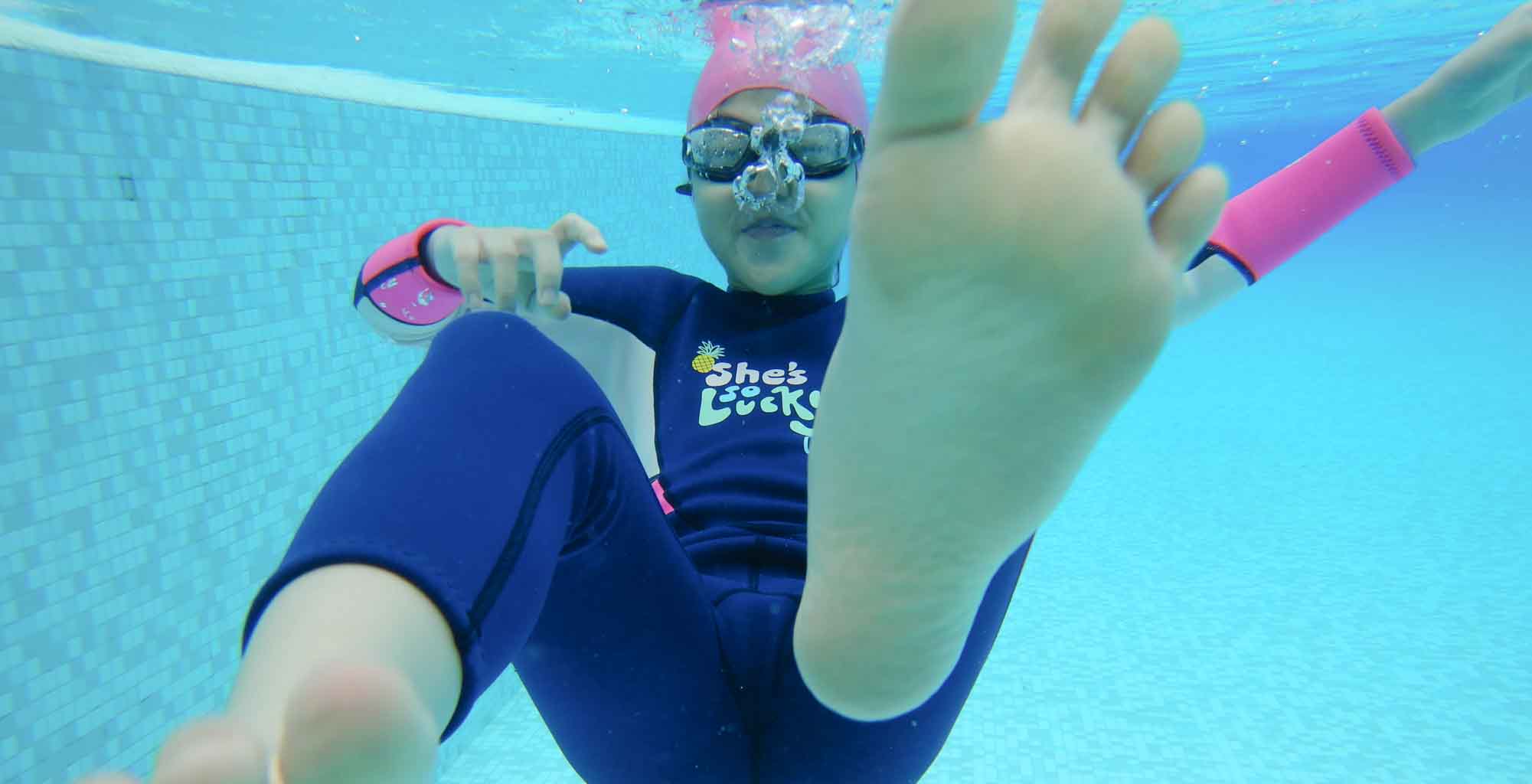7 Techniques for Improving Your Swimming Breathing

Understanding Breathing In Swimming
Replenishing the body with oxygen is an essential requirement of any sport, but the increased difficulty of doing so while swimming makes breathing a fundamental aspect of the swimming technique.
To best nourish their bodies, swimmers must learn to breathe rhythmically. They must also learn to inhale and exhale along the line of the stroke to avoid disturbing their swimming forward pace.
In general, synchronizing the intake with the stroke’s recovery and the exhale with the power phase allows breathing to fit best into the forward motion without producing undue drag. Unfortunately, this timing also places the exhale at the most challenging point of the stroke.
As in other sports and life, the swimmer can summon additional power by expending air while applying force.
Some swimming researchers feel that the swimmer’s natural breathing pattern should determine the swimming rhythm. Breathing is the key focus of this theory in establishing the most effective stroke rate, pace, and technique. Breathing technique has a role in your ability to swim better, whether sprinting 50 meters or swimming a mile.
Most competitive swimmers strive to be the fastest in their heat or final. The key to accomplishing this is to enhance your swimming breathing technique.
Even for novice or intermediate swimmers, learning to optimize your breathing can significantly increase your comfort in the water, not to mention your speed and endurance.
You can train your muscles, perfect your stroke, and even shave your entire body, but you may never attain your full potential if you neglect your breathing.
Poor breathing adds resistance to your swimming and exhausts your body. However, the better you breathe, the more oxygen you provide to your body, and the better you will perform.
Not sure where to begin? Don’t be concerned. We’ve assembled all the material that competitive and experienced swimmers need to improve their swimming breathing technique, from tactics to exercises, drills, and advice.
The Appropriate Swimming Breathing Cadence
The first question you may have about your swimming breathing technique is how frequently you should take breaths.
This is determined by several factors, including your stroke, how fast you swim, and whether you’re sprinting or swimming a long distance.
You can pick when you breathe in many swimming styles. For example, you could breathe every second, third, fourth, or more strokes in a freestyle. Others, such as the butterfly, allow swimmers to breathe once, twice, or thrice per stroke.
Finally, synchronizing your breath with the rhythm of your stroke is beneficial.
Your Swim Breathing Technique’s Influence on Your Speed
Because it influences your stroke and form, your swimming breathing technique significantly impacts your speed in the water.
Swimming breathing strategies and more effective patterns can allow you to employ fuller and more forceful strokes.
Swimming Breathing Techniques to Improve
You should know one thing immediately: no quick fix for enhancing your swimming breathing technique.
Like anything else in swim training, improving your breath control for swimming takes time, patience, and commitment.
However, these exercises, drills, techniques, and recommendations will assist you in breathing better and more efficiently in the pool and open water.
1. Employ Bob Progression Drills.
A simple bobbing exercise can help you push your lungs and increase their capacity.
This is how it works.
Begin by bobbing to your hairline in the pool or open water, then progress deeper and longer.
While doing so, concentrate on maintaining a consistent flow of bubbles from your nose. You can even expel your breath via your mouth if necessary.
Takeaway: Do this bob progression practice for as long as you feel comfortable. Each time you practice, push yourself to go deeper and for a longer period.
2. Swim in the Correct Body Position
Swimming with your head high and your hips low creates extra drag in the water and jeopardizes your form with each breath.
When swimming, practicing optimal body position will assist you in improving your respiration, stroke technique, and pace.
If you notice yourself sinking when breathing, it’s possible that you’re not supporting your body correctly.
If you take your breath and repeatedly pull with the arm that is in the water and opposite to the side from which you are inhaling, you will have nothing to support your body and keep it up in the water.
By keeping your arm extended in front of you while breathing, you can stay raised in the water and support your body by making it longer and, as a result, more balanced when distributing weight from your hands to your feet.
As you breathe, keep your arm stretched out in front of you, and then begin pulling with that arm as you lower your head back into the water.
Takeaway: Work with a teammate or coach who can observe and comment on your swimming form and breathing technique in the water.
3. Experiment with Bilateral Breathing
It is critical to practice bilateral breathing when swimming freestyle. This entails taking breaths on odd strokes and alternating the side on which you take them.
This is a crucial ability to master to improve your performance in a swimming competition or a triathlon.
This is because a bilateral swimming breathing pattern produces symmetrical and balanced strokes, which makes swimming in a straight line easier, especially in open water.
It also teaches you to breathe comfortably on both sides, which is extremely useful if you face problems like another swimmer spraying water or the sun in your eyes during an open water competition.
Takeaway: To practice bilateral breathing, change your inhale and exhale ratio to an “out-out-in” count. Regardless of this adjustment, you’ll still want to keep your air moving and not hold it at any point.
Note: While some short-distance lane competitors may choose to compete with unilateral breathing, we strongly advise you to incorporate bilateral breathing into your training to balance your strokes.
4. Exhale Forcefully
Breathing is fundamentally a succession of inhales and exhales. Unfortunately, exhalation is often forgotten while discussing rhythmic swimming breathing strategies.
Many athletes report feeling winded during their swims, which they may attribute to oxygen debt or a decreased oxygen supply. In truth, you’re feeling winded because of a buildup of carbon dioxide (CO2).
While the body burns oxygen for fuel, CO2 is produced as a byproduct that must be expelled. You’ll feel disturbed throughout your swim if you take deep enough breaths to fill your lungs with oxygen but don’t fully expel to reduce CO2 accumulation.
To develop a rhythmic swimming breathing pattern, try to duplicate your breathing pattern outside of the water. After all, you don’t go down the street holding your breath and then trying to take a burst breath while you’re in pain.
Instead, you breathe in and out with the same natural rhythm when you’re in the water.
Takeaway: To release CO2 buildup, exhale vigorously via your nostrils and mouth. Breathing should be regular and smooth. Never take a breather or halt.
5. Use a Respirator to Train
A respiratory training gadget is a fantastic workout for training your swimming breathing technique that doesn’t even require placing your face in the water, whether you’re training for a 50-meter freestyle or a triathlon. You can use it on days when you’re not at the pool, lake, or ocean.
A respiratory training device has been compared to “weight training for your breathing muscles.” You can adjust the device’s resistance to make breathing more difficult. You can also use a nasal plug to inhale and exhale through the mouthpiece.
According to one research, swimmers who conducted 30 repetitions on a respiratory training device twice daily reduced their 100-meter swim time by 1.7%.
Purchase and include a respiratory training device in your dryland training. First, consult with your coach to determine how frequently you should use it. If not, follow the instructions included with your RPD.
6. Experiment with Diaphragmatic Breathing
The Diaphragmatic Breathing Technique (DBT), commonly known as belly breathing, is another technique to practice on dry land. This is accomplished by engaging your stomach, abdominal muscles, and diaphragm while breathing.
Diaphragmatic breathing improves lung filling by teaching you how to manage your inhalation and exhale while breathing.
Once you’ve mastered this technique on land, you can apply it in the water—first in practice or during a workout, then in competition.
This strategy can help you perform better on race day and recover faster.
Ask your coach about DBT breathing techniques. Begin by practicing this strategy on dry terrain before moving on to water.
7. Use Swimming Breathing Variation Drills.
You can execute a variety of advanced swimming sets and intervals to practice different versions of your swimming breathing skills.
Here are a few ideas to get you started.
Breathing Exercises of Various Types
Work on varying your breathing cadence across four lengths.
Breathe on both sides for the first one. Then, breathe only on one side for the following length. Then, breathe every three strokes for the next length. Then, on the final stretch, breathe in whichever way you want.
Intervals of Long Breathing
Try lengths with greater gaps between breaths to exercise your diaphragm and boost your lung capacity.
This could mean taking five breaths per five strokes or merely taking five breaths halfway through your length.
The length of time you swim between breaths depends on your fitness level and amount of swimming expertise.
Takeaway: Begin with the easier drills and work up as you become more comfortable. Your goal should be to push yourself outside of your comfort zone safely.
Perfecting your swimming breathing technique takes time, determination, and a planned strategy. However, the process becomes much simpler and more effective with the appropriate direction.


